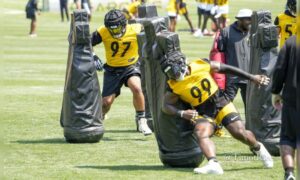The Pittsburgh Steelers are now into the offseason, following a year in which they had high hopes for Super Bowl success, but ultimately fell short of even reaching the postseason at 8-8. It was a tumultuous season, both on the field and within the roster, and the months to follow figure to have some drama as well, especially in light of the team’s failure to improve upon the year before.
The team made some bold moves over the course of the past year, and some areas of the roster look quite a bit different than they did a year ago, or even at the start of the regular season. Whether due to injuries or otherwise, a lot has transpired, and we’re left to wonder how much more will change prior to September.
How will Ben Roethlisberger’s rehab progress as he winds toward recovery from an elbow injury that cost him almost the entire season? What about some of the key young players, some of whom have already impressed, others still needing quite a bit of growth? Will there be changes to the coaching staff? The front office? Who will they not retain in free agency, and whom might they bring in?
These are the sorts of questions among many others that we have been exploring on a daily basis and will continue to do so. Football has become a year-round pastime and there is always a question to be asked, though there is rarely a concrete answer, as I’ve learned in my years of doing this.
Question: How high would Cameron Heyward have been drafted in 2011 in a weaker defensive end class?
This topic came up somewhat a couple of days ago when I wrote about Cameron Heyward’s comments about the Combine recently, during which he admits that he regrets he was injured when he attended the Combine.
Heyward was part of what is arguably a historically great defensive line class in 2011, which featured Marcell Dareus drafted third overall behind Von Miller. J.J. Watt was the first defensive end off the board at 11, then Robert Quinn at 14, and another tackle, Nick Fairley, in between.
Ryan Kerrigan went 16th, followed by Corey Liuget at 18. Adrian Clayborn came two selections later. Cameron Jordan would be drafted 24th, with Muhammad Wilkerson taken just ahead of Heyward at 30, before the Ohio State product finally became available to the Steelers at 31.
Almost all of the players named above have at least been to a Pro Bowl, so in general this class did a pretty good job of living up to expectations. But this is about those expectations, rather than what they would end up doing in their careers.
It’s fair to say nine years on that Heyward’s talent merits a spot higher than 31st in a draft class. In a weaker class for the defensive line, there’s reason to argue that he would have been. The question is, how high would he have been picked? You can consult this draft list if you really wish to be specific.








